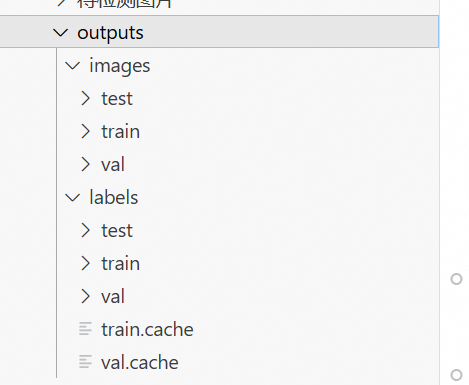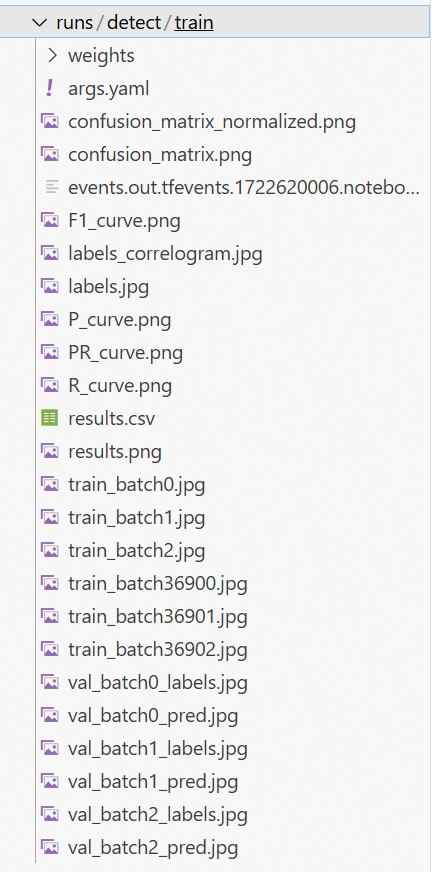借用Ultralytics Yolo快速训练一个物体检测器
借用Ultralytics Yolo快速训练一个物体检测器 [同步发表于 https://www.codebonobo.tech/post/14\](https://www.codebonobo.tech/post/14 "https://www.codebonobo.tech/post/14") 大约在16/17年, 深度学习刚刚流行时, Object Detection 还是相当高端的技术, 各大高校还很流行水Fast RCNN / Faster RCNN之类的论文, 干着安全帽/行人/车辆检测之类的横项. 但到了2024年, 随着技术成熟, 物体检测几乎已经是个死方向了, 现在的学校应该忙着把别人好不容易训练的通用大模型退化成各领域的专用大模型吧...哈哈 回到主题, 目前物体检测模型的训练已经流程化了, 不再需要费脑去写训练代码, 使用Ultralytics Yolo就可以快速训练一个特定物品的检测器, 比如安全帽检测. [https://github.com/ultralytics/ultralytics\](https://github.com/ultralytics/ultralytics)  # Step-1 准备数据集 你需要一些待检测物体比如安全帽, 把它从各个角度拍摄一下. 再找一些不相关的背景图片. 然后把安全帽给放大缩小旋转等等贴到背景图片上去, 生成一堆训练数据. 配置文件: ```python extract_cfg: output_dir: '/datasets/images' fps: 0.25 screen_images_path: '/datasets/待检测图片' max_scale: 1.0 min_scale: 0.1 manual_scale: [ {name: 'logo', min_scale: 0.05, max_scale: 0.3}, {name: 'logo', min_scale: 0.1, max_scale: 0.5}, {name: '箭头', min_scale: 0.1, max_scale: 0.5} ] data_cfgs: [ {id: 0, name: 'logo', min_scale: 0.05, max_scale: 0.3, gen_num: 2}, {id: 1, name: '截屏', min_scale: 0.1, max_scale: 1.0, gen_num: 3, need_full_screen: true}, {id: 2, name: '红包', min_scale: 0.1, max_scale: 0.5, gen_num: 2}, {id: 3, name: '箭头', min_scale: 0.1, max_scale: 0.5, gen_num: 2, rotate_aug: true}, ] save_oss_dir: /datasets/gen_datasets/ gen_num_per_image: 2 max_bg_img_sample: ``` 数据集生成: ```python from pathlib import Path import io import random import cv2 import numpy as np from PIL import Image import hydra from omegaconf import DictConfig import json from tqdm import tqdm # 加载图片 def load_images(background_path, overlay_path): background = cv2.imread(background_path) overlay = cv2.imread(overlay_path, cv2.IMREAD_UNCHANGED) return background, overlay # 随机缩放和位置 def random_scale_and_position(bg_shape, overlay_shape, max_scale=1.0, min_scale=0.1): max_height, max_width = bg_shape[:2] overlay_height, overlay_width = overlay_shape[:2] base_scale = min(max_height / overlay_height, max_width / overlay_width) # 随机缩放 scale_factor = random.uniform( min_scale * base_scale, max_scale * base_scale) new_height, new_width = int( overlay_height * scale_factor), int(overlay_width * scale_factor) # 随机位置 max_x = max_width - new_width - 1 max_y = max_height - new_height - 1 position_x = random.randint(0, max_x) position_y = random.randint(0, max_y) return scale_factor, (position_x, position_y) def get_resized_overlay(overlay, scale): overlay_resized = cv2.resize(overlay, (0, 0), fx=scale, fy=scale) return overlay_resized def rotate_image(img, angle): if isinstance(img, np.ndarray): img = Image.fromarray(cv2.cvtColor(img, cv2.COLOR_BGRA2RGBA)) # 确保图像具有alpha通道(透明度) img = img.convert("RGBA") # 旋转原始图像并粘贴到新的透明图像框架中 rotated_img = img.rotate(angle, resample=Image.BICUBIC, expand=True) rotated_img = np.asarray(rotated_img) return cv2.cvtColor(rotated_img, cv2.COLOR_RGBA2BGRA) # 合成图片 def overlay_image(background, overlay_resized, position, scale): h, w = overlay_resized.shape[:2] x, y = position # 透明度处理 alpha_s = overlay_resized[:, :, 3] / 255.0 alpha_l = 1.0 - alpha_s for c in range(0, 3): background[y:y + h, x:x + w, c] = (alpha_s * overlay_resized[:, :, c] + alpha_l * background[y:y + h, x:x + w, c]) # 画出位置,调试使用 # print("position", x, y, w, h) # cv2.rectangle(background, (x, y), (x + w, y + h), (0, 255, 0), 2) background = cv2.cvtColor(background, cv2.COLOR_BGR2RGB) return Image.fromarray(background) class Box: def init(self, x, y, width, height, category_id, image_width, image_height): self.x = x self.y = y self.width = width self.height = height self.image_width = image_width self.image_height = image_height self.category_id = category_id def to_yolo_format(self): x_center = (self.x + self.width / 2) / self.image_width y_center = (self.y + self.height / 2) / self.image_height width = self.width / self.image_width height = self.height / self.image_height box_line = f"{self.category_id} {x_center} {y_center} {width} {height}" return box_line class SingleCategoryGen: def init(self, cfg, data_cfg, output_dir): self.output_dir = output_dir self.screen_png_images = [] self.coco_images = [] self.coco_annotations = [] screen_images_path = Path( cfg.screen_images_path.format(user_root=user_root)) self.manual_scale = {} self.data_cfg = data_cfg self.category_id = data_cfg.id self.category_name = self.data_cfg.name self.max_scale = self.data_cfg.max_scale self.min_scale = self.data_cfg.min_scale self.gen_num = self.data_cfg.gen_num self.rotate_aug = self.data_cfg.get("rotate_aug", False) self.need_full_screen = self.data_cfg.get("need_full_screen", False) self.category_num = 0 self.category_names = {} self.butcket = get_oss_bucket(cfg.bucket_name) output_dir = Path(output_dir) save_oss_dir = f"{cfg.save_oss_dir}/{output_dir.parent.name}/{output_dir.name}" self.save_oss_dir = save_oss_dir self.images_save_oss_dir = f"{save_oss_dir}/images" self.label_save_oss_dir = f"{save_oss_dir}/labels" self.annotations_save_oss_path = f"{save_oss_dir}/annotations.json" self.load_screen_png_images_and_category(screen_images_path) def load_screen_png_images_and_category(self, screen_images_dir): screen_images_dir = Path(screen_images_dir) category_id = self.category_id screen_images_path = screen_images_dir / self.category_name img_files = [p for p in screen_images_path.iterdir() if p.suffix in [ ".png", ".jpg"]] img_files.sort(key=lambda x: x.stem) for i, img_file in enumerate(img_files): self.screen_png_images.append( dict(id=i, name=img_file.stem, supercategory=None, path=str(img_file))) def add_new_images(self, bg_img_path: Path, gen_image_num=None, subset="train"): gen_image_num = gen_image_num or self.gen_num background_origin = cv2.imread(str(bg_img_path)) if background_origin is None: print(f"open image {bg_img_path} failed") return max_box_num = 1 for gen_id in range(gen_image_num): background = background_origin.copy() category_id = self.category_id overlay_img_path = self.sample_category_data() overlay = cv2.imread(overlay_img_path, cv2.IMREAD_UNCHANGED) if overlay.shape[2] == 3: overlay = cv2.cvtColor(overlay, cv2.COLOR_BGR2BGRA) if self.rotate_aug: overlay = rotate_image(overlay, random.uniform(-180, 180)) # # 随机裁剪图片 # if random.random() < 0.5: # origin_height = overlay.shape[0] # min_height = origin_height // 4 # new_height = random.randint(min_height, origin_height) # new_top = random.randint(0, origin_height - new_height) # overlay = overlay[new_top:new_top+new_height, :, :] box_num = random.randint(1, max_box_num) # 获取随机缩放和位置 max_scale = self.max_scale min_scale = self.min_scale scale, position = random_scale_and_position( background.shape, overlay.shape, max_scale, min_scale) # 缩放overlay图片 overlay_resized = get_resized_overlay(overlay, scale) # 合成后的图片 merged_img = overlay_image(background, overlay_resized, position, scale) # 保存合成后的图片 filename = f"{bg_img_path.stem}{category_id}{gen_id:02d}.png" merged_img.save(f'{output_dir}/{filename}') # 生成COCO格式的标注数据 box = Box(*position, overlay_resized.shape[1], overlay_resized.shape[0], category_id, background.shape[1], background.shape[0]) self.upload_image_to_oss(merged_img, filename, subset, [box]) def sample_category_data(self): return random.choice(self.screen_png_images)["path"] image_id = self.gen_image_id() image_json = { "id": image_id, "width": image.width, "height": image.height, "file_name": image_name, } self.coco_images.append(image_json) annotation_json = { "id": image_id, "image_id": image_id, "category_id": 0, "segmentation": None, "area": bbox[2] * bbox[3], "bbox": bbox, "iscrowd": 0 } self.coco_annotations.append(annotation_json) def upload_image_to_oss(self, image, image_name, subset, box_list=None): image_bytesio = io.BytesIO() image.save(image_bytesio, format="PNG") self.butcket.put_object( f"{self.images_save_oss_dir}/{subset}/{image_name}", image_bytesio.getvalue()) if box_list: label_str = "\n".join([box.to_yolo_format() for box in box_list]) label_name = image_name.split(".")[0] + ".txt" self.butcket.put_object( f"{self.label_save_oss_dir}/{subset}/{label_name}", label_str) def upload_full_screen_image(self): if not self.need_full_screen: return name = self.category_name category_id = self.category_id image_list = self.screen_png_images subset_list = ["train" if i % 10 <= 7 else "val" if i % 10 <= 8 else "test" for i in range(len(image_list))] for i in range(len(image_list)): image_data = image_list[i] subset = subset_list[i] overlay_img_path = image_data["path"] image = Image.open(overlay_img_path) if random.random() < 0.5: origin_height = image.height min_height = origin_height // 4 new_height = random.randint(min_height, origin_height) new_top = random.randint(0, origin_height - new_height) image = image.crop( (0, new_top, image.width, new_top + new_height)) filename = f"{name}{category_id}{i:05}.png" box = Box(0, 0, image.width, image.height, category_id, image.width, image.height) self.upload_image_to_oss(image, filename, subset, [box]) class ScreenDatasetGen: def init(self, cfg, output_dir): self.output_dir = output_dir self.screen_png_images = {} self.coco_images = [] self.coco_annotations = [] screen_images_path = Path( cfg.screen_images_path.format(user_root=user_root)) self.max_scale = cfg.max_scale self.min_scale = cfg.min_scale self.manual_scale = {} for info in cfg.manual_scale: self.manual_scale[info.name] = dict( max_scale=info.max_scale, min_scale=info.min_scale) self.category_num = 0 self.category_names = {} self.category_id_loop = -1 self.butcket = get_oss_bucket(cfg.bucket_name) output_dir = Path(output_dir) save_oss_dir = f"{cfg.save_oss_dir}/{output_dir.parent.name}/{output_dir.name}" self.save_oss_dir = save_oss_dir self.images_save_oss_dir = f"{save_oss_dir}/images" self.label_save_oss_dir = f"{save_oss_dir}/labels" self.annotations_save_oss_path = f"{save_oss_dir}/annotations.json" self.load_screen_png_images_and_category(screen_images_path) def add_new_images(self, bg_img_path: Path, gen_image_num=1, subset="train"): background_origin = cv2.imread(str(bg_img_path)) if background_origin is None: print(f"open image {bg_img_path} failed") return max_box_num = 1 for gen_id in range(gen_image_num): background = background_origin.copy() category_id = self.get_category_id_loop() overlay_img_path = self.sample_category_data( category_id, subset=subset) overlay = cv2.imread(overlay_img_path, cv2.IMREAD_UNCHANGED) if overlay.shape[2] == 3: overlay = cv2.cvtColor(overlay, cv2.COLOR_BGR2BGRA) # # 随机裁剪图片 # if random.random() < 0.5: # origin_height = overlay.shape[0] # min_height = origin_height // 4 # new_height = random.randint(min_height, origin_height) # new_top = random.randint(0, origin_height - new_height) # overlay = overlay[new_top:new_top+new_height, :, :] box_num = random.randint(1, max_box_num) # 获取随机缩放和位置 category_name = self.category_names[category_id] if category_name in self.manual_scale: max_scale = self.manual_scale[category_name]["max_scale"] min_scale = self.manual_scale[category_name]["min_scale"] else: max_scale = self.max_scale min_scale = self.min_scale scale, position = random_scale_and_position( background.shape, overlay.shape, max_scale, min_scale) # 缩放overlay图片 overlay_resized = get_resized_overlay(overlay, scale) # 合成后的图片 merged_img = overlay_image( background, overlay_resized, position, scale) # 保存合成后的图片 filename = f"{bg_img_path.stem}{category_id}{gen_id:02d}.png" # merged_img.save(f'{output_dir}/{filename}') # 生成COCO格式的标注数据 box = Box(*position, overlay_resized.shape[1], overlay_resized.shape[0], category_id, background.shape[1], background.shape[0]) self.upload_image_to_oss(merged_img, filename, subset, [box]) # self.add_image_annotion_to_coco(box, merged_img, filename) def upload_full_screen_image(self, category_name=None): if category_name is None: return if not isinstance(category_name, list): category_name = [category_name] for category_id in range(self.category_num): name = self.category_names[category_id] if name not in category_name: continue image_list = self.screen_png_images[category_id] subset_list = ["train" if i % 10 <= 7 else "val" if i % 10 <= 8 else "test" for i in range(len(image_list))] for i in range(len(image_list)): image_data = image_list[i] subset = subset_list[i] overlay_img_path = image_data["path"] image = Image.open(overlay_img_path) if random.random() < 0.5: origin_height = image.height min_height = origin_height // 4 new_height = random.randint(min_height, origin_height) new_top = random.randint(0, origin_height - new_height) image = image.crop( (0, new_top, image.width, new_top + new_height)) filename = f"{name}{category_id}{i:05}.png" box = Box(0, 0, image.width, image.height, category_id, image.width, image.height) self.upload_image_to_oss(image, filename, subset, [box]) def load_screen_png_images_and_category(self, screen_images_dir): screen_images_dir = Path(screen_images_dir) screen_images_paths = [ f for f in screen_images_dir.iterdir() if f.is_dir()] screen_images_paths.sort(key=lambda x: x.stem) for category_id, screen_images_path in enumerate(screen_images_paths): img_files = [p for p in screen_images_path.iterdir() if p.suffix in [ ".png", ".jpg"]] img_files.sort(key=lambda x: x.stem) self.screen_png_images[category_id] = [] self.category_names[category_id] = screen_images_path.stem print(f"{category_id}: {self.category_names[category_id]}") for i, img_file in enumerate(img_files): self.screen_png_images[category_id].append( dict(id=i, name=img_file.stem, supercategory=None, path=str(img_file))) self.category_num = len(screen_images_paths) print(f"category_num: {self.category_num}") def get_category_id_loop(self): # self.category_id_loop = (self.category_id_loop + 1) % self.category_num self.category_id_loop = random.randint(0, self.category_num - 1) return self.category_id_loop def sample_category_data(self, category_id, subset): image_data = self.screen_png_images[category_id] # valid_id = [] # if subset == "train": # valid_id = [i for i in range(len(image_data)) if i % 10 <= 7] # elif subset == "val": # valid_id = [i for i in range(len(image_data)) if i % 10 == 8] # elif subset == "test": # valid_id = [i for i in range(len(image_data)) if i % 10 == 9] # image_data = [image_data[i] for i in valid_id] return random.choice(image_data)["path"] def gen_image_id(self): return len(self.coco_images) + 1 def add_image_annotion_to_coco(self, bbox, image: Image.Image, image_name): image_id = self.gen_image_id() image_json = { "id": image_id, "width": image.width, "height": image.height, "file_name": image_name, } self.coco_images.append(image_json) annotation_json = { "id": image_id, "image_id": image_id, "category_id": 0, "segmentation": None, "area": bbox[2] * bbox[3], "bbox": bbox, "iscrowd": 0 } self.coco_annotations.append(annotation_json) def upload_image_to_oss(self, image, image_name, subset, box_list=None): image_bytesio = io.BytesIO() image.save(image_bytesio, format="PNG") self.butcket.put_object( f"{self.images_save_oss_dir}/{subset}/{image_name}", image_bytesio.getvalue()) if box_list: label_str = "\n".join([box.to_yolo_format() for box in box_list]) label_name = image_name.split(".")[0] + ".txt" self.butcket.put_object( f"{self.label_save_oss_dir}/{subset}/{label_name}", label_str) def dump_coco_json(self): categories = [{key: item[key] for key in ("id", "name", "supercategory")} for item in self.screen_png_images.values()] coco_json = { "images": self.coco_images, "annotations": self.coco_annotations, "categories": categories } self.butcket.put_object( self.annotations_save_oss_path, json.dumps(coco_json, indent=2)) # with open(f"{self.output_dir}/coco.json", "w") as fp: # json.dump(coco_json, fp, indent=2) @hydra.main(version_base=None, config_path=".", config_name="conf") def main(cfg: DictConfig): output_dir = hydra.core.hydra_config.HydraConfig.get().runtime.output_dir # get_image_and_annotation(output_dir) # screen_dataset_gen = ScreenDatasetGen(cfg, output_dir) category_generators = [] for data_cfg in cfg.data_cfgs: category_generators.append(SingleCategoryGen(cfg, data_cfg, output_dir)) bg_img_files = [f for f in Path(cfg.extract_cfg.output_dir.format(user_root=user_root)).iterdir() if f.suffix in [".png", ".jpg"]] if cfg.get("max_bg_img_sample"): bg_img_files = random.sample(bg_img_files, cfg.max_bg_img_sample) img_index = 0 for bg_img_file in tqdm(bg_img_files): subset = "train" if img_index % 10 <= 7 else "val" if img_index % 10 == 8 else "test" img_index += 1 for category_generator in category_generators: category_generator.add_new_images(bg_img_path=bg_img_file, subset=subset) for category_generator in category_generators: category_generator.upload_full_screen_image() if name == 'main': main() ``` 运行后, 可以在outputs文件夹下生成符合要求的训练数据.  image 就是背景+检测物体 labels 中的内容就是这样的文件: ```python 1 0.6701388888888888 0.289453125 0.5736111111111111 0.57421875 # 类型 box ``` # Step-2 训练模型 这个更简单, 在官网下载一个模型权重, 比如yolo8s.pt, 对付安全帽这种东西, 几M大的模型就够了. 训练配置文件: ```python names: 0: logo 1: 截屏 2: 红包 path: /outputs test: images/test train: images/train val: images/val ``` 训练代码: 没错就这么一点 ```python from ultralytics import YOLO model = YOLO('./yolo8s.pt') model.train(data='dataset.yaml', epochs=100, imgsz=1280) ``` 然后就可以自动化训练了, 结束后会自动保存模型与评估检测效果.  # Step-3 检测 检测代码示意: ```python class Special_Obj_Detect(object): def init(self, cfg) -> None: model_path = cfg.model_path self.model = YOLO(model_path) self.model.requires_grad_ = False self.cls_names = {0: 'logo', 1: '截屏', 2: '红包'} # 单帧图像检测 def detect_image(self, img_path): results = self.model(img_path) objects = [] objects_cnt = dict() objects_area_pct = dict() for result in results: result = result.cpu() boxes = list(result.boxes) for box in boxes: if box.conf < 0.8: continue boxcls = box.cls[0].item() objects.append(self.cls_names[boxcls]) objects_cnt[self.cls_names[boxcls]] = objects_cnt.get(self.cls_names[boxcls], 0) + 1 area_p = sum([ (xywh[2]*xywh[3]).item() for xywh in box.xywhn]) area_p = min(1, area_p) objects_area_pct[self.cls_names[boxcls]] = area_p objects = list(set(objects)) return objects, objects_cnt, objects_area_pct ``` 收工.